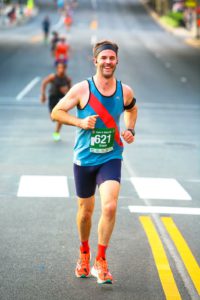Proximal Hamstring Tendinopathy: Trevor’s Success Story
Trevor’s Background

We are excited to share Trevor’s inspiring success story. Trevor’s journey is a testament to the importance of proper diagnosis, effective rehabilitation, and the resilience of the human spirit.
Before we dive into Trevor’s success story, let’s get to know him a bit better. Trevor resides in Washington DC and originally hails from California. He has always been an active person with a background in various sports, but in recent years, he dedicated more time to running, including participating in marathons and half marathons. Trevor had big plans for his running journey, but little did he know, proximal hamstring tendinopathy was about to enter the picture.
The Onset of Proximal Hamstring Tendinopathy
Trevor’s journey with proximal hamstring tendinopathy began in the lead-up to a marathon in April of the previous year. He decided to run some tune-up races to prepare for the big event, and here’s where the trouble started. Trevor made the common mistake of pushing too hard during one of these races, running at a pace he hadn’t trained for. He shared an example of running a 10-miler at a pace 15 seconds faster than his recent half marathon, setting the stage for the injury.
Soon after this race, Trevor began to experience a pulling sensation in his right hamstring, near the glute attachment. Instead of heeding the warning signs, he continued running, hoping the issue would resolve itself. However, over the next week, the condition worsened, prompting Trevor to seek medical advice. Unfortunately, the initial diagnosis from a medical doctor missed the mark, attributing the pain to calf tendonitis, despite the pain extending into his calf.
Running the planned marathon did not exacerbate the pain, so Trevor continued with his training. However, when he resumed running post-marathon, the pain returned, and Trevor found himself on a quest to uncover the true nature of his injury.
Misdiagnosis and Frustration
Trevor’s journey took him to various healthcare professionals, including physical therapists and doctors. However, he encountered a series of misdiagnoses and inadequate treatment plans. One physical therapist, in particular, couldn’t pinpoint the issue and believed it to be a calf muscle problem. This misdiagnosis led to several weeks of incorrect treatment and exercises.
As the months passed, Trevor’s pain worsened, and he began experiencing discomfort when sitting, a common symptom of proximal hamstring tendinopathy. By July, he noticed a loss of strength in his hamstring and was leaning to one side when sitting to relieve the pain. At this point, Trevor started doing some research on his own, trying to identify his proximal hamstring tendinopathy condition and develop a suitable rehab plan.
The Turning Point
In August, Trevor began working with another physical therapist who had experience with running injuries. While this therapist provided some relief, Trevor was still not making significant progress. He continued to experiment with exercises and stretches, searching for the right approach to his rehabilitation.
It was around this time that Trevor discovered the Run Smarter podcast and found value in the information shared. He recognized the need for a more effective rehab plan and decided to schedule a free 20-minute injury chat with Brodie Sharpe, the host of the podcast and an online physiotherapist.
The Run Smarter Approach
During their chat in late October, Brodie provided Trevor with valuable guidance and recommendations. The major takeaways from their discussion included:
1. Gradual Progression of Weight
Brodie emphasized the importance of gradually increasing the weight load during exercises. Trevor had been using moderate weights, but Brodie encouraged him to add more resistance progressively.
2. Transition to Double-Leg Deadlifts
Brodie recommended switching from single-leg Romanian deadlifts (RDLs) to double-leg RDLs. This change allowed Trevor to use heavier weights and improved the effectiveness of his hamstring strengthening exercises.
3. Incorporating Hip Extension Exercises
Brodie suggested incorporating hip extension exercises, which Trevor had not previously included in his rehab plan. These exercises further targeted the hamstring and glute muscles.

Trevor’s Hamstring Tendinopathy Success
Following these recommendations, Trevor implemented the changes in his rehab routine. He increased the weight load, switched to double-leg RDLs, and added hip extension exercises. Almost immediately, he noticed a significant reduction in pain and discomfort. Trevor’s progress was evident, and his condition began to improve rapidly.
With his updated rehab plan, Trevor experienced a newfound sense of hope and relief from the persistent pain that had plagued him for months. He continued to make progress and resumed running with greater confidence and comfort.
Proximal Hamstring Tendinopathy Lessons and Takeaways
Trevor’s story offers valuable lessons for individuals dealing with Proximal Hamstring Tendinopathy:
- Seek an accurate diagnosis early in your journey to expedite recovery.
- Be patient and trust the rehabilitation process; significant improvements may take time.
- Don’t hesitate to change your approach if you’re not seeing results; adapt and refine your treatment plan.
- Invest in your knowledge and take an active role in your healthcare decisions.
- Embrace strength training as a means of injury prevention and performance enhancement.
Trevor’s journey is a testament to the power of resilience, determination, and informed decision-making in overcoming Proximal Hamstring Tendinopathy. By learning from his experiences, individuals battling PHT can approach their own recovery journeys with greater confidence and understanding.

